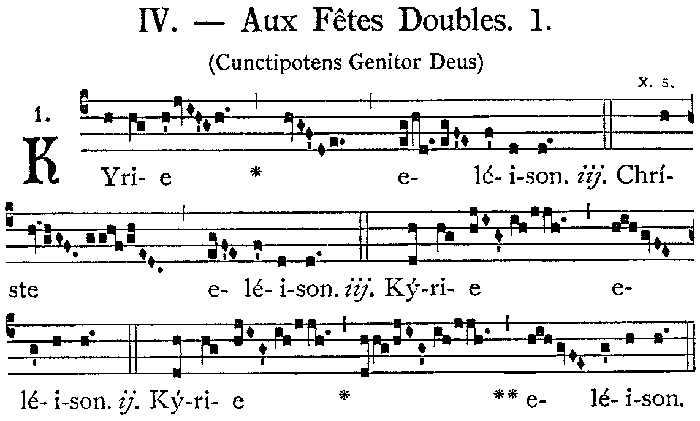From the eighth century we have record of the performance of the Kyrie Eleison in the Roman church. Kyries come from Greek traditions and are sung in Greek instead of Latin. In the mass, the Kyrie is sung after the chanting of the Introit. Traditionally, each line of the Kyrie is chanted three times to signify, through numerology, Catholics' belief in the threefold nature of the divine. Further, each group of prayers is addressed to a different aspect of the Trinity: the first to God, the Father; the second to God, the Son; and the third to God, the Holy Spirit. Medieval commentators also often made connection between the nine supplications of the chant and the nine choirs of angels in heaven.
Kyries are characterized by long series of untexted music, as can be clearly heard in this chant at the elision (the point at which the two words coincide) of the two words Kyrie_eleison. As these untexted musical passages became longer and more ornate, monks began to add words to the various notes of the melisma as you can hear in the second version of the Kyrie: Kyrie Cunctipotens genitor.
Chants (and later vocal works) that feature many notes for one syllable of text are known as melismatic.
This particular Kyrie can be dated back to the days of the Romano-Frankish church of at least the tenth-century. The number four, as in Kyrie IV, means that it is from the fourth plainchant setting of the mass as notated in the Liber Usualis, the book which contains many of the chants of the Catholic church.
Like all medieval chant, this Kyrie was performed monophonically, in unison and with a free meter. When such Kyries are performed nowadays, it is common practice to accompany the chant with the organ and sing them in a more rhythmic and metric manner, however given the rather poor articulation of medieval organs, and the likelihood that rhythm, as we know it, was an unknown concept in the medieval church, such performances are considered inauthentic. An example of a modern performance of this chant can be heard here as performed by the monks of St. Benedict's monastery of Sao Paolo, Brazil. To hear their versions of the many other settings of the Kyrie, access their webpage.
The melody of this Kyrie is focused around the pitch "D" and the note a fifth higher "A." This strong melodic focus accounts for the listener's satisfaction at the end of each phrase. Note also how the opening half of each presentation of Kyrie is the same.

Anonymous: Kyrie IV (before 1000)
| Kyrie Eleison | 0:00 | Small group of soloists sing melismatic line of music (a) in unison. |
| Kyrie Eleison | 0:18 | Full choir repeats melody (a). |
| Kyrie Eleison | Third repeat is omitted |
|
| Christe Eleison | 0:38 | Small group of soloists sing a different melismatic line of music (b) in unison. |
| Christe Eleison | 0:55 | Full choir repeats melody (b). |
| Christe Eleison | Third repeat is omitted |
|
| Kyrie Eleison | 1:10 | Small group sings longer melismatic melody (c) in unison. |
| Kyrie Eleison | 1:28 | Full choir sings modified version of (c). Note how the opening half of the phrase, the antecedent is repeated before moving on to the second half of the phrase, the consequent. |
Translation
| Kyrie Eleison | Lord have mercy | |
| Christe Eleison | Christ have mercy | |
| Kyrie Eleison | Lord have mercy |

The score as it looks in modern chant notation
All text © Todd Tarantino 2002-2012.
Not to be reprinted without permission.
www.toddtarantino.com
Contact